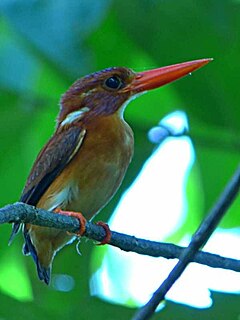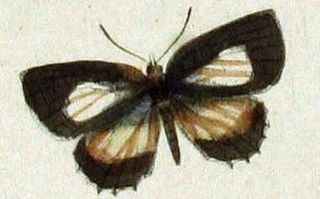
The eastern dwarf tree frog, also known as the eastern sedge-frog, is a small and very common tree frog found on the eastern coast of Australia, from around Cairns, Queensland, to around Ulladulla, New South Wales. Individual frogs of this species are often found elsewhere, having been accidentally relocated by transported fruit boxes. Confirmed sightings of breeding pairs have confirmed their survival in Victoria's cooler climate.

Nepenthes stenophylla, or the narrow-leaved pitcher-plant, is a tropical pitcher plant endemic to Borneo. The species produces attractive funnel-shaped pitchers up to 25 cm high. It is listed as Least Concern on the IUCN Red List. Nepenthes stenophylla belongs to the loosely defined "N. maxima complex", which also includes, among other species, N. boschiana, N. chaniana, N. epiphytica, N. eymae, N. faizaliana, N. fusca, N. klossii, N. maxima, N. platychila, and N. vogelii.

Orchis mascula, the early-purple orchid, early spring orchis, is a species of flowering plant in the orchid family, Orchidaceae.

Sida fallax, known as yellow ilima or golden mallow, is a species of herbaceous flowering plant in the Hibiscus family, Malvaceae, indigenous to the Hawaiian Archipelago and other Pacific Islands. Plants may be erect or prostrate and are found in drier areas in sandy soils, often near the ocean. ʻIlima is the symbol of Laloimehani and is the flower for the islands of Oʻahu, Hawaiʻi, and Abemama, Kiribati.
Mycobacterium fallax is a species of the phylum Actinomycetota, belonging to the genus Mycobacterium.

The Northern Luzon shrew-rat is a species of rodent in the family Muridae. It is found only in the Philippines. Its natural habitat is subtropical or tropical dry forest. It is threatened by habitat loss.
The creek groove-toothed swamp rat is a species of rodent in the family Muridae. It is found in Angola, Burundi, Democratic Republic of the Congo, Kenya, Malawi, Mozambique, Namibia, Rwanda, Tanzania, Uganda, Zambia, and Zimbabwe. Its natural habitats are moist savanna and pastureland.

Jouanin's petrel is a species of seabird in the family Procellariidae.

The Sulawesi dwarf kingfisher is a species of bird in the family Alcedinidae that is endemic to Sulawesi island, Indonesia. The species has numerous common names such as Celebes forest kingfisher, blue-crowned kingfisher, Celebes dwarf-kingfisher, and Celebes pygmy-kingfisher.

The Greater Antillean elaenia is a species of bird in the family Tyrannidae. It is found on Hispaniola and Jamaica.

The San Diego pocket mouse is a rodent species in the family Heteromyidae. It occupies the northern region of Baja California near San Diego extending into Mexico.

The twait shad or twaite shad is a species of fish in the family Clupeidae. It is found in the eastern Atlantic Ocean and the Mediterranean Sea and is an anadromous fish which lives in the sea but migrates into fresh water to spawn. In appearance it resembles an Atlantic herring but has a row of six to ten distinctive spots on its silvery flanks. They become mature when three or more years old and migrate to estuaries, later swimming up rivers to spawn. Populations of this fish have declined due to overfishing, pollution and habitat destruction. Conservation of this species is covered by Appendix III of the Bern Convention and Appendix II and V of the European Community Habitats Directive.

The European cat snake, also known as the Soosan snake, is a venomous colubrid snake endemic to the Mediterranean and Caucasus regions.

Tathorhynchus is a monotypic moth genus in the family Erebidae erected by George Hampson in 1894. Its only species, Tathorhynchus exsiccata, the Levant blackneck or double-spotted snout, was first described by Julius Lederer in 1855. The nominate form is found on the Canary Islands and in North Africa, tropical Asia and tropical Africa. It has been introduced in Dominica and Argentina. Subspecies Tathorhynchus exsiccata fallax is found in the northern half of Australia, as well as Norfolk Island and New Zealand.
Borbo fallax, the false swift, is a butterfly of the family Hesperiidae. It is found in tropical Africa. In South Africa it is found in Eswatini, coastal KwaZulu-Natal, northern Gauteng and the Limpopo Province and the extreme north-east of the North West Province. The habitat consists of coastal bush and moist savanna.

Lactarius fallax, commonly known as the velvety milk cap, is a species of fungus in the family Russulaceae. Found in both spruce and mixed conifer forests, it is a fairly common species in the Pacific Northwest region of North America, with a northerly range extending to Alaska. Its fruit bodies are medium-sized, with velvety, brown to blackish caps up to 3–9 cm (1.2–3.5 in) in diameter bearing a distinct pointed umbo. The caps are supported by velvety stems up to 6 cm (2.4 in) long and 1.5 cm (0.6 in) thick. The mushroom oozes a whitish latex when it is cut, and injured tissue eventually turns a dull reddish color. The eastern North American and European species Lactarius lignyotus is closely similar in appearance, but can be distinguished by its differing range.

Elegia fallax is a moth of the family Pyralidae. It is known from Spain, Portugal, France, Italy, Croatia, the Czech Republic, Slovenia, Hungary, Romania, Bulgaria, North Macedonia and Greece. It has also been recorded from the Channel Islands in 2005.

Allotinus fallax is a butterfly in the family Lycaenidae. It is found in Asia.
Dacrila is a genus of beetle belonging to the family Staphylinidae.
Fallax is a genus of brachiopods belonging to the family Aulacothyropsidae.















